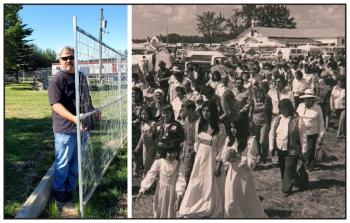Image Caption
Summary
Local Journalism Initiative Reporter
Windspeaker.com
The Métis community at Lac Ste. Anne may not have learned about Pope Francis’ upcoming visit through official channels, but “sometimes good things come out of controversial issues,” said Tracy Friedel, spokesperson for the Lac Ste. Anne Métis community.
“In this case I think the really good thing is the (Catholic) church and the community are working closely together now and have some plans to foster that relationship even further going forward. That's a positive thing for sure.”
The Holy Father’s final stop in his three days in Alberta will be at the Lac Ste. Anne pilgrimage next Tuesday afternoon.
The Pope flies into Edmonton on July 24. He will return to Rome on July 29 from Iqaluit. In between, he will spend two days in Quebec City.
Friedel says the Lac Ste. Anne Métis community only became aware the rumours were true that they were on the Pope’s agenda when they saw equipment moved in to pave and beautify the pilgrimage site.
The work, which includes a sidewalk from the shrine to the lake, raised concerns with the local Métis as there are unmarked graves in the area.
“It's really where Lac Ste. Anne Métis community emerged, if you want to call it that, in the mid 1800s. It's been a core area for the Lac Ste. Anne Métis going back more than 165 years. We know that some of those graves were interred at the site there back in the 1800s. It was a cemetery at one time,” said Friedel. The community’s website states that the Metis have occupied the area before the arrival of Oblate missionaries in the mid-1800’s.
But the headstones were removed several decades ago and “over the years there's some different stories about that,” said Friedel.
The local Métis community has been working for years to get the site protected, she says, and the urgency became apparent with the announcement that between 25,000 to 40,000 people would attend the pilgrimage in a single day—the usual number for the entire four-day event—and the unmarked graves could be trampled and disrespected.
Up until that point, says Friedel, the relationship between the Métis community and the Catholic church was “nonexistent.”
“Somewhere along the way the community’s relationship with the church had become broken to an extent,” she said.
However, the urgency of the concerns about the unmarked graves in the historic cemetery prompted discussions between the Métis community and the Edmonton Archdiocese.
“What's happening now is the community is working quite closely with the Archdiocese to ensure that those (graves) are protected at the time as the papal visit where there will be a lot of people on site,” said Friedel.
A fence will protect the area at this point.
“There will be some more long-term efforts, collaborations following the papal visit to better identify and protect that location as well. So there are some really good things that have come out of this,” she said.
As for Pope Francis choosing Lac Ste. Anne as one of his handful of hour-long public stops in his six days in Canada, Friedel says she can understand it.
The lake, called “Wakamne” by the Alexis Nakota Sioux or “God’s Lake,” has been a prominent spiritual gathering place for Indigenous people for the past 125 years.
“It makes sense from my perspective that (the Pope) would want to come there himself as a pilgrim. I think it will be very meaningful to a lot of Indigenous people who do come there,” said Friedel.
Speaking for the Lac Ste. Anne Métis Community, she said, “We interpret his visit as couched more in the spirit of reconciliation, really trying to change the channel on that relationship. There's a lot of work to do…It takes a lot to begin to change because the church has been the church for a long time. We're only beginning to see a little bit more from the Catholic church now.”
The Holy Father will be coming to Lac Ste. Anne the day after he makes his “principle statement”—expected to include an official apology—at Maskwacis, the site of the only Indian residential school that the Pope will be visiting. The Ermineskin school was one of the largest residential schools run by the Catholic church in Canada.
“I've spoken to a lot of (Métis) people who don't want anything to do with (the visit), don't agree with him coming, don't believe the church is sincere in this. But for many others, they are very devout. For them this is extremely meaningful. I think we just have to honour and respect the whole spectrum of feelings that people have about this,” said Friedel.
Friedel will be going to Lac Ste. Anne with some community Elders when Pope Francis is there.
Access to the site on the day the Pope is in attendance will be limited to those with tickets. Park-and-ride, group charter or walking will be the only ways to get there.
There will be 3,000 support workers on site the day the Pope visits.
In the late afternoon of July 26, highways 16, 43 and 633 will be impacted when the Pope travels to and from Lac Ste. Anne.
Local Journalism Initiative Reporters are supported by a financial contribution made by the Government of Canada.

